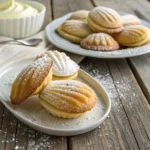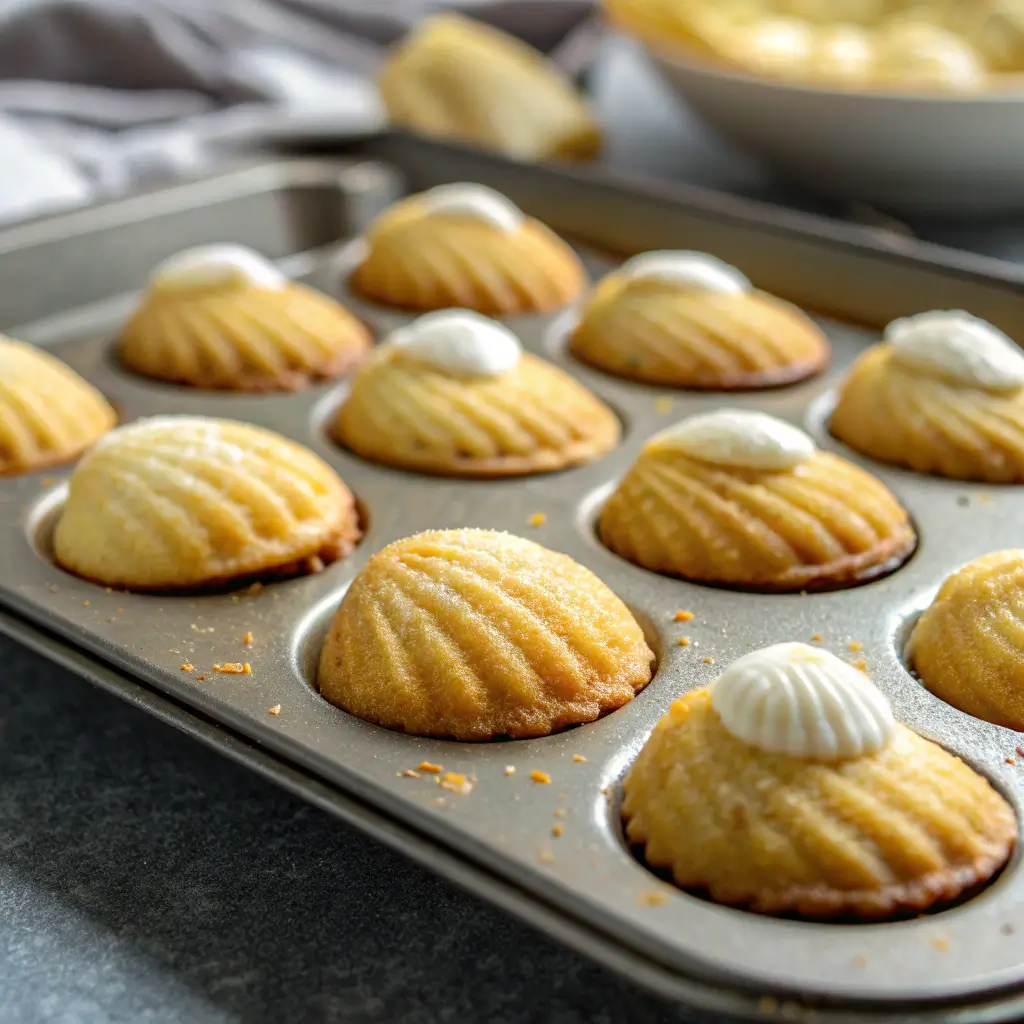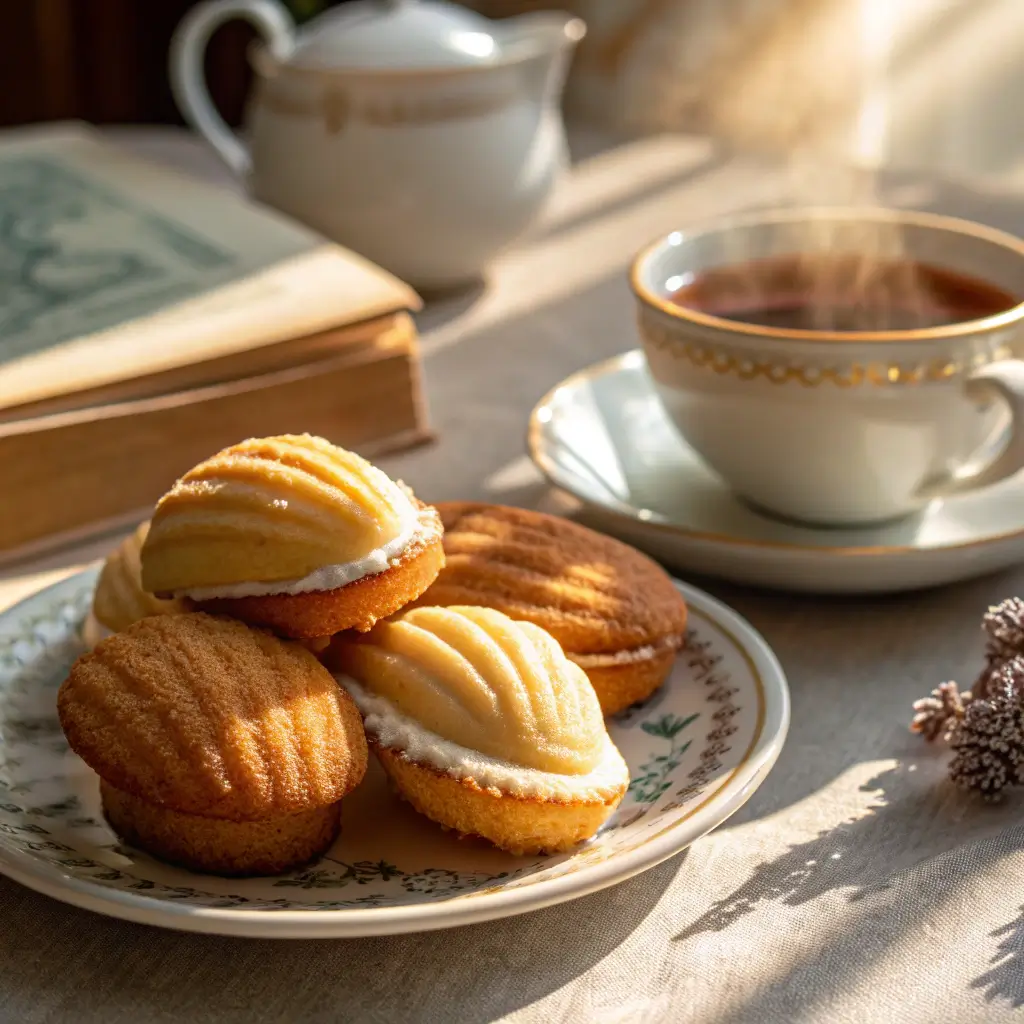Madeleine cookies with cream are a soft, buttery twist on the classic French treat — and they’re even more irresistible than the original. Each bite offers a delicate balance of crisp golden edges and a tender, melt-in-your-mouth center. By adding rich heavy cream to the traditional butter-and-egg base, you create madeleines that are moister, more tender, and bursting with a richer, creamier flavor than the classic recipe.
The beauty of this little upgrade is that it doesn’t just change the taste — it transforms the whole experience. The cream locks in moisture, so your Madeleine cookies with cream stay fresh and soft even the next day, making them perfect for baking ahead. They also take on a velvety crumb and a subtle richness that elevates every bite.
These elegant, shell-shaped delights are perfect for afternoon tea, coffee breaks, or simply treating yourself when you want something special without too much fuss. Their iconic shape and light texture make them just as beautiful to serve as they are satisfying to eat. In this guide, we’ll take you step-by-step through the process of making Madeleine cookies with cream that rival any bakery’s, reveal the tricks for achieving that signature domed hump, share tips to avoid common baking mistakes, and explore creative variations you’ll want to make again and again.
For more baking inspiration and kitchen tips, follow us on Facebook where we share recipes, videos, and behind-the-scenes baking fun.
Table of Contents

The Charm of Madeleine Cookies with Cream
The French Origin of Madeleines
Madeleine cookies with cream may be a modern twist, but they’re inspired by a tradition that goes back centuries. These elegant shell-shaped sponge cakes originated in the Lorraine region of France, where they were famously baked by Madeleine Paulmier for a duke in the 18th century. Over time, they became a signature of French patisserie, loved for their light crumb, golden edges, and delicate sweetness.
Though often called “cookies” in English, they’re more like miniature sponge cakes. When made as Madeleine cookies with cream, they’re even more irresistible — tender, moist, and perfect with a warm drink. The cream keeps them soft for longer, so you can enjoy them fresh even the next day.
Print
Madeleine Cookies with Cream – Soft, Buttery & Irresistible
- Total Time: 1 hr 25 mins
- Yield: 12 servings 1x
Description
Soft, buttery French madeleines made even better with the richness of heavy cream. Perfect for tea time or dessert.
Ingredients
- 2 large eggs
- 1/2 cup granulated sugar
- 1 cup all-purpose flour
- 1/2 tsp baking powder
- 1/4 tsp salt
- 1/2 cup unsalted butter, melted
- 1/4 cup heavy cream
- 1 tsp vanilla extract
- Powdered sugar for dusting
Instructions
- In a mixing bowl, whisk together the eggs and sugar until pale and fluffy.
- Sift in the flour, baking powder, and salt, folding gently until combined.
- Stir in the melted butter, heavy cream, and vanilla extract until smooth.
- Cover the batter and chill in the refrigerator for 1 hour.
- Preheat oven to 375°F (190°C). Grease a madeleine pan.
- Spoon the batter into the molds, filling each about 3/4 full.
- Bake for 10–12 minutes or until the edges are golden and the centers spring back when touched.
- Cool in the pan for 2 minutes before transferring to a wire rack.
- Dust with powdered sugar before serving.
Notes
Chilling the batter helps create the classic madeleine hump. Do not overmix once the flour is added.
- Prep Time: 15 mins
- Cook Time: 10–12 mins
- Category: Dessert
- Cuisine: French
Nutrition
- Serving Size: 1 serving
- Calories: 160
- Fat: 9g
- Carbohydrates: 18g
- Protein: 2g
Why Adding Cream Changes Everything
Classic madeleines use melted butter for richness, but cream adds a luxurious upgrade. Heavy cream transforms both texture and taste:
- Locks in moisture so Madeleine cookies with cream stay soft and tender.
- Creates a smoother, finer crumb that melts in your mouth.
- Deepens the buttery flavor, making each bite more indulgent.
Another bonus? Cream makes the batter silkier, which means it pipes more evenly into the madeleine pan. This helps create the famous domed “hump” that makes these cookies so iconic. One small ingredient swap, and you’ll have bakery-level results right from your own kitchen.
Key Ingredients for Perfect Madeleines
The Essential Baking Staples
To make bakery-quality Madeleine cookies with cream, start with high-quality basics. Each ingredient plays a role in the texture, flavor, and signature golden edges:
- All-purpose flour (1 cup) – The backbone of your cookies, giving them structure while keeping the crumb delicate.
- Baking powder (1 teaspoon) – Ensures they puff up beautifully in the oven, contributing to that classic madeleine hump.
- Salt (1/4 teaspoon) – Balances sweetness and enhances overall flavor.
- Granulated sugar (2/3 cup) – Sweetens and helps create a golden crust.
The Star Ingredient – Heavy Cream
Here’s where we break tradition. While classic recipes rely on butter alone, heavy cream brings something extra to the table:
- Extra moisture – Prevents the cookies from drying out.
- Richer flavor – Cream adds a mild sweetness and fuller taste.
- Finer crumb – Gives your madeleines that melt-in-your-mouth texture.
For best results, use full-fat heavy cream — lower-fat alternatives won’t give the same tenderness or flavor depth.
Supporting Flavors That Make a Difference
- Unsalted butter (1/2 cup, melted and cooled) – Adds richness and a slightly crisp edge.
- Eggs (2 large) – Provide structure and help achieve a fluffy interior.
- Vanilla extract (1 teaspoon) – Brings warmth and sweetness to the overall flavor profile.
- Lemon zest (1 teaspoon, optional) – Adds a fresh, citrusy lift that pairs beautifully with the buttery base.
When combined, these ingredients create Madeleine cookies with cream that are light, tender, and irresistibly flavorful. The heavy cream is the hero, but the supporting cast ensures everything works in perfect harmony.
Tools You’ll Need for Flawless Results
Essential Madeleine Baking Equipment
To get perfect Madeleine cookies with cream, the right tools make all the difference. You don’t need a fancy kitchen setup, but having these essentials will help you achieve the light, airy texture and signature shell shape every time:
- Madeleine baking pan – Creates the distinctive shell design that sets these cookies apart.
- Mixing bowls – At least two, so you can keep wet and dry ingredients separate before combining.
- Whisk – For incorporating air into the batter without overmixing.
- Measuring cups and spoons – Accuracy is key for balanced flavor and perfect texture.
Optional Tools for Added Precision
If you want to make your Madeleine cookies with cream look and taste like they came from a French bakery, these extras can help:
- Piping bag – Makes it easier to fill the molds neatly and evenly.
- Zester – Perfect for adding fresh lemon zest or other citrus notes.
- Cooling rack – Prevents soggy bottoms and helps cookies cool evenly.
Having the right gear not only simplifies the process but also ensures consistent results — so every batch of Madeleine cookies with cream turns out light, moist, and picture-perfect.
Step-by-Step Madeleine Cookies with Cream Recipe
Preparing the Batter
The magic of Madeleine cookies with cream starts with a light, well-mixed batter. Here’s how to get it right:
- Whisk the eggs and sugar – In a large mixing bowl, whisk 2 large eggs and ⅔ cup granulated sugar until the mixture is pale and frothy. This step builds air into the batter for that signature sponge-like texture.
- Add flavorings – Stir in 1 teaspoon of vanilla extract and, if you like, 1 teaspoon of lemon zest for a fresh twist.
- Mix dry ingredients separately – In another bowl, sift together 1 cup all-purpose flour, 1 teaspoon baking powder, and ¼ teaspoon salt.
- Combine gently – Gradually fold the dry mixture into the wet mixture, being careful not to overmix — you want your Madeleine cookies with cream to stay light and airy.
- Incorporate butter and cream – Gently stir in ½ cup melted, cooled unsalted butter and ¼ cup heavy cream until smooth.
Chilling for the Signature Hump
One of the defining features of Madeleine cookies with cream is that lovely domed hump in the center. The secret is to chill the batter before baking:
- Cover the bowl with plastic wrap and refrigerate for at least 1 hour.
- For even better results, chill overnight — this deepens the flavor and improves the rise.
Chilling allows the batter to firm up so that when it hits the hot oven, it springs upward, forming that classic hump.
Baking Like a Pro
Achieving the Perfect Bake
Once your batter is well chilled, it’s time to transform it into golden, shell-shaped perfection. For Madeleine cookies with cream, the bake is just as important as the mix:
- Preheat your oven – Set it to 375°F (190°C). A hot oven helps create the signature rise.
- Prepare your pan – Lightly grease and flour the madeleine molds to prevent sticking and give a crisp edge.
- Fill evenly – Spoon or pipe the chilled batter into each mold, filling about three-quarters full.

Bake for 10–12 minutes, or until the edges are golden brown and the centers have risen beautifully.
Getting the Golden Crust & Hump
The beauty of Madeleine cookies with cream is in the contrast — soft, moist centers with slightly crisp, golden edges. To get that perfect balance:
- Avoid opening the oven door during the first half of baking — sudden drops in temperature can flatten the hump.
- Rotate the pan in the last few minutes for even browning.
- Remove from the oven as soon as the tops spring back lightly when touched.
Let the cookies cool in the pan for 2 minutes, then transfer to a cooling rack. This keeps the bottoms from getting soggy while locking in the delicate texture that makes Madeleine cookies with cream so irresistible.
Creative Flavor Variations
Chocolate-Dipped Madeleines
For a decadent twist, turn your Madeleine cookies with cream into chocolate lovers’ heaven. Once cooled, dip one end of each cookie into melted dark or milk chocolate. Let them set on parchment paper until the chocolate hardens. You can even sprinkle crushed nuts or coconut over the chocolate for extra texture and flavor.
If you want a more intense cocoa flavor inside the cookie itself, replace 2 tablespoons of the flour in your batter with unsweetened cocoa powder. This keeps the crumb moist while adding a rich chocolate depth.
Citrus & Nutty Twists
One of the easiest ways to brighten up Madeleine cookies with cream is with citrus zest. Lemon is a classic choice, but orange and lime also work beautifully. Add the zest to your wet ingredients for a fragrant, fresh flavor.
For a nuttier profile, mix 2 tablespoons of finely ground almonds, pistachios, or hazelnuts into the dry ingredients before combining. Nuts add a subtle crunch and complement the creaminess of the batter perfectly.
These variations let you adapt Madeleine cookies with cream for any occasion — from a fancy afternoon tea to a casual weekend treat.
Serving & Pairing Ideas
Perfect Drinks to Serve with Madeleines
Few things beat the comfort of enjoying Madeleine cookies with cream alongside the perfect drink. A classic choice is a hot cup of Earl Grey or chamomile tea, both of which complement the cookies’ buttery richness. Coffee lovers can pair them with a smooth cappuccino or latte for a cozy café experience at home.
For something a little different, try serving them with hot chocolate — the rich cocoa enhances the creaminess of the cookies. If you enjoy citrus, a cup of freshly brewed lemon tea is also an excellent pairing, bringing a bright contrast to the buttery base.

Sweet Garnishes & Dips
Madeleine cookies with cream are delicious on their own, but a few finishing touches can make them even more special:
- Dust lightly with powdered sugar for a delicate, bakery-style look.
- Serve with a side of fruit jam — raspberry, apricot, or strawberry work beautifully.
- Dip the bottom in white or dark chocolate for an elegant twist.
- Add a dollop of whipped cream or mascarpone on the side for extra indulgence.
Whether served at a tea party or as an after-dinner treat, Madeleine cookies with cream pair effortlessly with both warm drinks and sweet accompaniments.
Storage & Freezing Tips
Keeping Madeleines Moist & Fresh
Freshly baked Madeleine cookies with cream are best enjoyed the day they’re made, but with proper storage, you can keep them tasting great for longer. Place cooled cookies in an airtight container at room temperature for up to 3 days. To help maintain their softness, add a slice of bread inside the container — the cookies will absorb just enough moisture to stay tender.
Avoid refrigerating them, as the cool air can dry them out faster. Instead, store them in a cool, dry place away from direct sunlight.
Learn more about how to store baked goods
Freezing for Long-Term Enjoyment
You can freeze Madeleine cookies with cream to enjoy them weeks later. Here’s how:
- Skip the powdered sugar before freezing — add it after reheating for a fresh look.
- Arrange cookies in a single layer on a baking sheet and freeze until solid.
- Transfer them to a freezer-safe container or bag, separating layers with parchment paper.
They’ll keep well for up to 2 months. To serve, reheat in a 300°F (150°C) oven for about 5 minutes or let them thaw at room temperature. The texture and flavor will remain wonderfully close to freshly baked.
Can you make cookies with cream instead of milk?
Yes! Using cream instead of milk in cookie recipes adds richness, moisture, and a smoother crumb. In the case of Madeleine cookies with cream, the extra fat content helps them stay soft longer and gives each bite a more luxurious texture.
What’s so special about madeleine cookies?
Madeleines are famous for their shell shape, delicate crumb, and slightly crisp edges. When you make Madeleine cookies with cream, you enhance those qualities with even more tenderness and flavor, creating a treat that’s as beautiful as it is delicious.
What are common madeleine baking mistakes?
Some frequent missteps include overmixing the batter (which can make them dense), skipping the chilling step (which helps form the hump), and overbaking (which dries them out). Sticking to the proper method ensures your Madeleine cookies with cream come out perfect every time.
What do you eat madeleines with?
Madeleine cookies with cream pair wonderfully with tea, coffee, or hot chocolate. You can also enjoy them with fruit jam, whipped cream, or even dipped in melted chocolate for an indulgent twist.
Conclusion
Madeleine cookies with cream are proof that a small twist on a classic recipe can make a big difference. By adding heavy cream to the traditional French batter, you get cookies that are softer, moister, and even more flavorful — without losing the iconic golden edges and signature hump.
With just a few simple ingredients, the right tools, and a little chilling time, you can bake Madeleine cookies with cream that rival anything you’d find in a Parisian bakery. Whether you stick to the classic vanilla and lemon zest or experiment with chocolate, citrus, and nutty variations, these treats are perfect for afternoon tea, coffee breaks, or special gatherings.
So, grab your madeleine pan, whisk up some batter, and let your kitchen fill with the rich, buttery aroma of Madeleine cookies with cream. One bite, and you’ll understand why this upgraded version has become a favorite for home bakers everywhere.
And if you’re hunting for more delicious dessert ideas, check out our Pinterest boards — packed with sweet treats and baking inspiration for every occasion.
